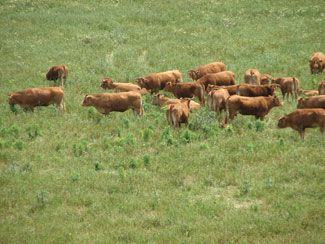Abortion in Andorran cows

Neospora caninum causes abortion losses in both dairy and beef cattle in many countries. However, relatively little is known about the disease in beef cattle since most of the studies have been performed on dairy herds. The present study presents the results of a serological survey performed to analyze Neospora caninum seroprevalence and risk factors affecting seroprevalence in beef cattle in Andorra. Over 5-years blood samples were collected from 1,758 cattle in 26 herds reared in 5 different regionscalled “parroquias”. All herds were included in the genetic program for improvement of Bruna d’Andorra (Brown Swiss) breed, and were under the government health control program for quality meat of Andorra. Sera were tested using the commercial ELISA (CIVTEST©, Hipra, Girona, Spain) according to the manufacturer’s instructions. We also tested the sera of 8 dogs owned by farmers with beef herds in the area using the Indirect Immunofluorescence Test (IFAT).
Almost 85% of the 26 herds analyzed had been exposed to N. caninum and had at least 1 seropositive animal. Although herd prevalence was high, animal prevalence was low (7.4%). The low animal prevalence of the disease in Andorra´s herds is probably related to the extensive management in which the probability of contact with oocysts is lower than in dairy cattle kept under more confined conditions. In addition, in dairy herds, larger numbers of animals are replaced within the herd, increasing the risk of vertical, or endogenous, transplacental transmission.
During the study years, no significant seroprevalence differences were observed, suggesting an enzootic situation of N. caninum infection. Age, summer grazing area of the herds, and breed emerged as the main risk factors affecting seroprevalence of infection in the country. Differences in seroprevalence were highly significant between age groups such that, based on the odds ratio, cows ≥ 5-yr-old had a risk of infection that was increased by a factor of 1.64. These results suggest that N. caninum seropositivity increases with age in extensive systems and would indicate that horizontal or exogenous transplacental transmission in the grazing areas is the main route of transmission in the beef cattle herds of Andorra. Canids are considered the main risk factor for post-natal transmission of N. caninum. In the present study, 5 of 8 dogs tested had N. caninum antibodies. Dogs walked by their owners, along with hunting dogs and sled dogs in winter, are common in the pastures grazed by cattle in the spring. It is not known whether there are any definitive hosts of N. caninum in Andorra other than dogs. Red foxes are common in the areas of study and have been observed eating aborted fetuses and placentas in high mountain areas. The summer grazing area was also identified as a major risk factor for N. caninum infection. During the summer months, animals in different herds graze together and these grazing areas could be a common source of oocysts. Another risk factor identified for N. caninum infection was cattle breed. Limousin-mixed Limousin animals showed a significantly lower seroprevalence (6.7 times lower) compared to other breeds, including Charolais and Bruna d’Andorra (Brown Swiss). Future studies should examine the possibility that certain breeds, e.g., Limousin, are less susceptible to N. caninum infection than others.
In conclusion, the results of the present study suggest that the grazing site can promote the horizontal transmission of N. caninum infection in extensively managed cattle in high mountain areas and that under this type of management certain breeds are less susceptible to N. caninum infection than others.
References
“LOW SEROPREVALENCE OF NEOSPORA CANINUM INFECTION ASSOCIATED WITH THE LIMOUSIN BREED IN COW-CALF HERDS IN ANDORRA, EUROPE” Ramon Armengol, Marcela Pabón, Carles Adelantado, Fernando López-Gatius, Sonia Almería. Journal of Parasitology 93 (5): 1029-1032.


